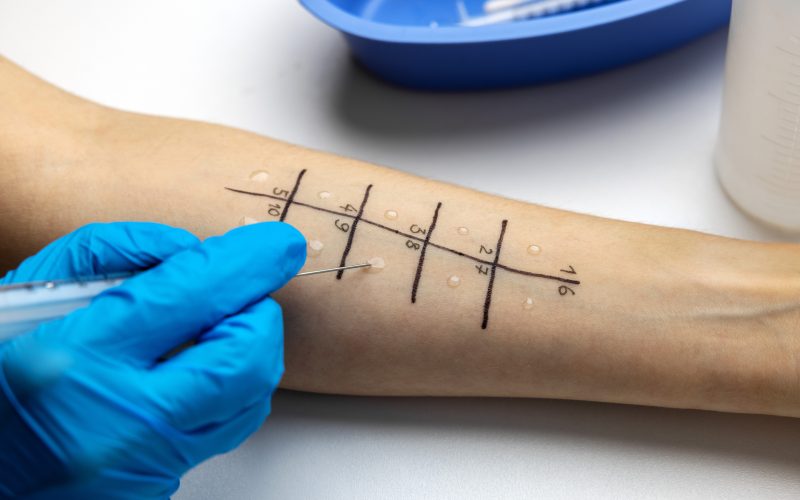Geert Houben, PhD is a principal scientist at TNO (an independent Dutch applied science and technology organization) and a professor at UMC Utrecht and Utrecht University. He researches the effects of food ingredients on the immune system and food toxicology. Together with his team, Geert has worked for many years to improve allergen labeling on food products. Ultimately, this aims to ensure that warnings are meaningful and do not unnecessarily carry labels such as ‘may contain allergens’ or ‘may contain traces of peanuts’. Geert was recently interviewed by Anniek Hoogeveen for the Dutch trade magazine “Allergie en Voeding”.
What exactly is your research on allergies about?
“With our research, we want to determine what the exact threshold levels for allergens are worldwide. A threshold value is the maximum amount of an allergen that a person can consume without being dangerous. The goal is to translate these values into concentrations in food products. This will help determine when a label warning is needed, while taking into account both threshold values and consumption patterns in the population.”
What is the role of the WHO and FAO in this research?
“The World Health Organization (WHO) and the Food and Agriculture Organization of the United Nations (FAO), at the request of the Codex Alimentarius of the United Nations International Food Standards Program, established a committee to develop global guidelines for allergen labeling. This work drew heavily on data and methods developed by TNO and UMC Utrecht. The committee recommended that action limits be based on the median consumption value, rather than the extreme consumption of heavy users. The approach that we take is to ensure that warnings are meaningful and do not unnecessarily label products with warnings such as ‘may contain allergens’.”
“The approach that we take is to ensure that warnings are meaningful and do not unnecessarily label products with warnings such as ‘may contain allergens’.”
Where does the research stand now?
“We have many results because the research started back in the 1990s. In particular, we focus on determining the threshold value of allergens. This is the amount that a consumer is allowed to ingest and is yet not dangerous. If you want to use that dosage, you also have to take into account the amount a person normally eats. And then translate that into concentrations of allergens in food products. So then you have to divide the maximum dosage of an allergen that is safe by the portion size of the food. And then you actually get a concentration, and that’s an action limit where you should or shouldn’t put a warning on the label. A second focus of our research is on the level of consumption. The current advice is not to take an extreme amount of what the most extreme consumer would take in. Because then you are going back into a worst-case scenario and again you get every food with a ‘may contain allergens’ label. And with a warning like that everywhere, the allergic consumer doesn’t get anywhere.”
Where are the biggest challenges in this research?
“Getting the right data on food intake from different countries. Several countries do not want to share this data unconditionally. However, this input is crucial for us to be able to draw up valid international guidelines. Therefore, we have to convince countries that data sharing is a win-win situation. In addition, there are also all kinds of translation problems. For example, we are now also looking at a Chinese database. This is quite a challenge because the characters are so different from European languages.”
How do you categorize the food products?
“We’re talking about products that are simply available in the supermarket, in particular the end products that the allergic consumer actually eats. Based on research, we can see that about 3,000 foods in the Netherlands, can be reduced via categorization to about 40 product groups. For example, there are many types of bread that can be placed in one category. Because ultimately a certain amount of whole wheat tiger bread belongs in the same category as a bun, if the risk of cross-contamination as well as the amount of consumption is comparable.”
How exactly is the allergenicity of a product determined?
“The risk of an allergic reaction is determined by the sensitivity of the allergic consumer (the threshold level), the concentration of a particular allergen in a food product and the amount of that food consumed during a typical meal. Different eating occasions need not be added together. Usually, the interval between meals is sufficient for the body to ‘reset’. We also did simulations with, for example, bread that may contain nuts combined with a topping that may also contain traces of nuts. We have shown that there is no need to add up the risks of possible contamination in bread and the toppings, because the additional risk is negligible. This is because the risk that both products contain the allergen at the same time and that the concentrations are simultaneously high is very small”.
“Our goal is to provide consumers with better information and thus protect them.”
What is the ultimate goal of your research?
“Our goal is to provide consumers with better information and thus protect them. It’s not necessarily about reducing the number of products with ‘may contain traces of…’ per se. It is, however, about making food labeling meaningful. Currently, the presence or absence of a warning is not correlated to whether or not there is a risk associated with a product. We want to eliminate that.”
What about the deliberate addition of allergens as ingredients by food companies to avoid the risk of an incorrect allergen label?
“With the new rules and the new health-based limits, hopefully this is something that will become less prevalent. Because this is indeed a situation we saw recently. It is unclear what caused this behavior, but it could be related to the fact that in 2016 the Dutch Food and Consumer Product Safety Authority had set very low standards for allergen concentrations in food products.”
How is it possible that countries are implementing this new legislation faster than that it is finally regulated internationally through Codex Alimentarius?
“This is related to the fact that many parties have been asking for solutions to this problem for a long time, especially on allergen risk labeling as a precautionary measure, the so-called ‘precautionary allergen labeling’. Allergic consumers are used to dealing with such risks which is unique, because in many other food safety situations so-called zero risk concepts are involved. Allergic consumers understand that you have to find a balance there, which helps significantly in the acceptance of the new rules.”
“In the near future, allergic consumers will be able to really rely on the presence, but also the absence, of precautionary allergen labeling. I expect that this will also reduce the number of unexpected allergic reactions.”
What specifically will allergic consumers be able to notice in a year from now?
“In the near future, allergic consumers will be able to really rely on the presence, but also the absence, of precautionary allergen labeling. I expect that this will also reduce the number of unexpected allergic reactions. Our research has shown that roughly half of all food allergy patients have two or more allergic reactions per year. There will also hopefully be more information transfer about the new rules, as the proposal is to set up training programs so that the new situation is explained properly. Several stakeholders are working on this, including TNO.”
Finally, what message would you like to give to stakeholders?
“It may help to see everything in a larger perspective when it comes to the legislation around allergen labeling. This is because there are multiple stakeholders in this development, including allergic consumers, health authorities and companies. It is impossible to get it maximally right for everyone. A balance needs to be found, which is practically implementable and as much as possible in line with the wishes of all stakeholders. I am confident that we are moving, step by step, toward better information about allergens.”
This article is based on an interview by Anniek Hoogeveen for the magazine “Allergie & Voeding” of the Dutch Food Allergy Foundation from March 2025 (www.voedselallergie.nl).

